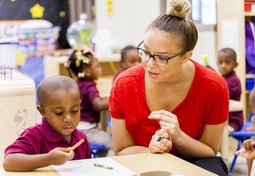A New Guide for Kindergarten Readiness
 A new study from the Pritzker Children’s Initiative and The Bridgespan Group estimates that 1 in 4 kindergarteners nationwide – 1 million total – come from low-income families and enter school not fully ready to learn.
The report, titled, “Achieving Kindergarten Readiness for All Our Children: A Funder’s Guide to Early Childhood Development from Birth to Five,” is based on 18 months of research and interviews with leading early childhood experts and current early childhood funders.
A new study from the Pritzker Children’s Initiative and The Bridgespan Group estimates that 1 in 4 kindergarteners nationwide – 1 million total – come from low-income families and enter school not fully ready to learn.
The report, titled, “Achieving Kindergarten Readiness for All Our Children: A Funder’s Guide to Early Childhood Development from Birth to Five,” is based on 18 months of research and interviews with leading early childhood experts and current early childhood funders.
The study both demonstrates the need for quality early learning, and provides tangible areas for investment to help expand early childhood opportunities and ensure children are arriving to kindergarten ready to learn.
Below is an overview of some of the most salient statistics, findings, and recommendations from the report.
Early Learning Statistics
- 1 in 4 American children come from low-income families and arrive to kindergarten not ready to learn.
- From conception to the first day of kindergarten, a child’s brain develops more quickly and a greater amount than at any other time.
- When a child enters kindergarten ready for school, there is an 82% chance the child will master basic skills by age 11 compared with a 45% chance for children who are not school ready.
- Effective parenting programs reached only 115,000 children in 2014, an estimated 5% of the need.
- In 2013-2014, only 5 states met all of the key quality benchmarks for pre-K programs (Alabama, Alaska, Mississippi, North Carolina, and Rhode Island).
- Investments in quality early childhood programs for disadvantaged children more than pay for themselves, with a return on investment of 7-10% per annum, as measured by better education, health, economic, and social mobility outcomes.
- Investments in the first 3 years of life are especially critical to prepare more children for kindergarten and lifelong success and provide the greatest returns on investment.
- Not investing in early childhood programs for low-income families results in larger taxpayer burdens in the education, health and criminal justice systems.
Five Areas of Development for Kindergarten Readiness
- Physical well-being and motor development
- Social and emotional development
- Cognitive skills
- Language and developing literacy
- Ability to concentrate and follow directions
Early Childhood Investment Opportunities
The report provides 13 philanthropic investment opportunities that have the potential to improve kindergarten readiness for a significant number of at-risk children while offering a high return on investment. The opportunities include investing in proven approaches as well as supporting ongoing research and innovation in specific areas.
Strengthen public systems of early care and education at state and local levels to ensure continuous quality improvements.
- Option 1: Provide technical assistance for states to accelerate quality-improvement efforts.
- Option 2: Fund training for providers pursuing quality improvements.
Scale health and developmental screenings to connect parents and families to resources to optimize their child’s holistic development.
- Option 3: Develop and share comprehensive screening and referral systems at the community level.
- Option 4: Support pediatric practices to integrate screenings and referrals into well-child visits.
- Option 5: Disseminate promising screening and assessment questionnaires and tools.
Improve the training, continuing education, professional development and compensation of early childhood educators.
- Option 6: Increase the availability of on-the-job coaching and development for early childhood educators.
- Option 7: Fund research and technical assistance to promote fair compensation of early childhood educators.
Support greater access to high-quality, evidence-based programs that help parents and families to foster their children’s development.
- Option 8: Build the capacity of organizations implementing evidence-based programs to serve more children and families.
- Option 9: Invest in innovative public-private financing mechanisms for evidence-based programs.
- Option 10: Expand evidence-based programs that educate parents by advocating for increased state, local and federal funding.
- Option 11: Simplify and disseminate information to assist parents in choosing high-quality care and education opportunities for their children.
Promote and share ongoing program innovation and improvement, especially for those programs supporting parents and informal caregivers.
- Option 12: Promote quality-improvement efforts for family, friend and neighbor care.
- Option 13: Foster innovation to achieve repeatable results.
To read the report in its entirety, click here.
